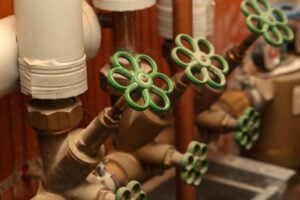Does Paint Peel Easier in the Bathroom from Excess Moisture?

Bathroom, toilet room interior close-up. The walls are painted green, covered with decorative ceramic tiles with white glossy bricks
Is your paint peeling in the bathroom? You may be wondering if moisture is the culprit. After all, bathrooms are inherently humid places and this can lead to a variety of problems with paint.
Fortunately, there are ways you can protect your walls from moisture-related damage and keep them looking good as new. In this article, we’ll discuss five things you can do to prevent paint from peeling in your bathroom due to excess moisture.
A High-Moisture Area
The bathroom is a high-moisture area, so it’s no surprise that moisture can cause paint to peel in the bathroom.
Paint peels because of changes in temperature and humidity levels – this is especially true in bathrooms where steam from hot showers or baths creates extra moisture. Over time, this moisture can weaken the adhesive qualities of paint, causing it to peel away from the wall.
While paint peeling in the bathroom can be an issue, there are some easy steps you can take to protect your paint and keep it looking great:
Prepare the Walls
1. Make sure the walls are properly prepped before painting. Before you begin painting in any area of your home, it’s important to make sure that the walls are properly cleaned and sanded. This will help ensure that your paint adheres better to the wall, helping to protect it from any moisture-related damage.
Use Primer
2. When painting in a high-moisture area like the bathroom, it’s important to use a primer that is specifically designed for bathrooms. This type of primer will provide extra protection against moisture and humidity, helping your paint job stay looking great for longer.
Choose Quality Paint
3. Make sure you choose a good quality paint that is appropriate for the bathroom. Not all paints are created equal, and certain types of paint may be more suitable for your needs than others.
When painting in a high-moisture area like the bathroom, it’s important to choose a paint that is designed for use in bathrooms and other wet environments. This type of paint will provide better protection against moisture-related damage.
Ventilation
4. Make sure the bathroom is well-ventilated. Make sure that you have a good ventilation system in place and keep windows open while showering to help air out any moisture from the room. This will help reduce the risk of paint peeling due to excess moisture.
Regular Maintenance
5. Make sure to keep up with regular maintenance. Regularly cleaning and maintaining your walls is essential for keeping them looking great over time.
Wipe down the walls periodically with a damp cloth, making sure to remove any dirt or dust that has accumulated in order to prevent it from damaging the paint. This will help keep your walls looking great for years to come.
By following the steps above, you can help ensure that your paint in the bathroom stays looking great and resists damage from moisture. Taking some simple steps to prepare the walls and choose quality products will go a long way in protecting your paint job and helping it stay looking perfect for years to come.
**Extra Tip:** Consider using semi-gloss paint for your bathroom. Semi-gloss paints contain more binders and resins, making them more resistant to moisture damage than flat paints. This is especially beneficial in high-moisture areas like the bathroom, where it’s essential to use paint that is resistant to humidity, water, and mold growth.




